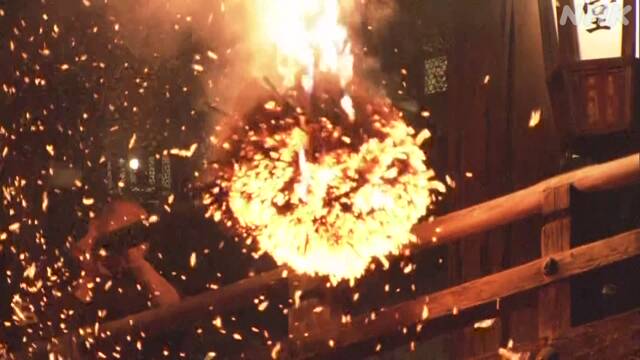Nara Todaiji Temple "Omizutori" Next year, some of the measures will be closed to the public as a measure against corona. November 5, 6:46
k10012695651_202011050642_202011050644.mp4
Regarding the method of opening next year's "Omizutori", a traditional event of Todaiji Temple that announces the arrival of spring to the ancient city of Nara, the temple shakes a large torch to scatter sparks to prevent the spread of the new coronavirus. It turned out that we are considering unusual measures such as a plan to keep some of the dates of "(Otamatsu)" private.
The "Shuni-e" at Todaiji Nigatsudo, known as "Omizutori," is a country where monks called "Rengyoshu" spend about a month in peace. It is a traditional event that holds memorial services to pray for, and will celebrate 1270 times next year, never stopping since the Nara period.
Among them, many worshipers visit "Omatsuaki", which shakes a torch that burns every night from March 1st to 14th from the parapet of Nigatsudo, so the temple received the advice of an infectious disease expert. We are considering how to publish next year.
Currently, I am thinking of keeping "Omatsuaki" private on March 12th, when large torches are used, and especially on March 13th and 14th, when many people visit.
On top of that, he calls for refraining from worshiping on other days, and if it is determined that crowding is unavoidable, he will consider limiting the number of people.
The temple plans to announce the response in the middle of this month, taking into account the future infection situation.
Butler Kimihide Hashimura of Todaiji Temple, who has served as a practitioner many times in the past, said, "We will hold the Shuni-e as usual, but we may need to refrain from worshiping depending on the fashion situation of the new corona. It's a very annoying decision, but I would like to ask for your understanding and cooperation. "
Considering countermeasures with the cooperation of infectious disease experts
This time, Todaiji has been considering infection control measures for the Shuni-e next year with the cooperation of Dr. Kei Kasahara, director of the Infectious Diseases Center, Nara Medical University Hospital.
The first thing we discussed was how to publish "Omatsuaki", which will be held every day from around 7:00 pm for two weeks from March 1st.
Currently, the national government has indicated that there should be a distance of 1 meter or more between people as a guide when holding festivals, etc., but more than 10,000 people visit Omatsuaki on many days.
Due to the limited space around Nigatsudo, it is difficult to avoid a “dense” situation where many people gather in a limited area without restrictions.
As a countermeasure, a plan such as keeping the last three days of "Omatsuaki" private is being considered.
In addition to how to open it to worshipers, it is the infection control measures for monks that bother the people concerned.
Eleven monks selected as trainees spend about a month in a training camp where they sleep and eat together.
According to Director Kasahara, if even one infected person appears, other monks will be required to be quarantined as close contacts, and the Shuni-e may have to be interrupted.
The temple, together with the director of the Kasahara Center, inspected the temples in the precincts and the facilities that serve as the priest's dormitory, but in the memorial service, each action and the position of the priest in the building were detailed. Some of them are fixed, and it is difficult to keep a distance from each other and wear masks thoroughly.
At the temple, it is necessary to take thorough measures to prevent the monks from bringing in the virus, so before the shuni-e started, all the monks who became the practitioners were isolated at home and a period of about two weeks was set up for health observation. In addition, we are considering measures such as having a PCR test performed in advance.
Director Kasahara said, "If you sleep and eat together in a training camp for a month, it is difficult to go while taking measures against infection, so it is important not to bring in the virus as much as possible. Next, the tradition that the people concerned have kept. I want to help you connect. "
Crisis of interruption in the past
The Shuni-e of Todaiji Temple has been held continuously since the Nara period, and is called "Futai no Gyobo".
In addition, it has been popular for a long time as a traditional event that announces the arrival of spring, and the pictures of the Edo period show the common people looking at the torches.
However, in the past there was a crisis of interruption several times, and in 1667 during the Edo period, Nigatsudo was completely destroyed by fire the day before the end of the Shuni-e, and the place was moved to another temple and went to the end. It is said that it was destroyed.
Also, in 1945, the diary of the trainees in the year of the end of the war stated that while the blackouts were being controlled, they had to go up to Nigatsudo one hour earlier so that they would not stand out, and then stopped the night torches. There is also a description.
Butler Kimihide Hashimura of Todaiji said, "The Shuni-e has continued with the support of various people who want it to continue, so I want to continue to inherit the thoughts of those people who are timeless. This is our wish. "

